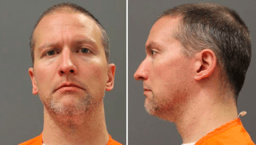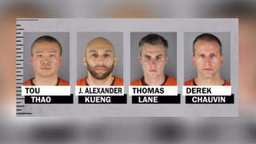Derek Chauvin (police officer)

Derek Chauvin (police officer)

Derek Chauvin kneeling on George Floyd's neck
Derek Chauvin (born March**** 19**,** 1976) is a former American police officer who served the Minneapolis Police Department. He received international media attention in late MAY 2020, after he killed George Floyd over his alleged use of a counterfeit $20 bill. Officer Chauvin knelt on Floyd's neck for at least seven minutes while he was handcuffed and lying chest down on the road. Chauvin's murder of Floyd sparked outrage across America and contributed to the Minneapolis riots of May 2020.
On May 29, 2020,Derek Chauvin (police officer) was arrested and charged with third-degree murder and manslaughter in the killing of George Floyd. [8] [1] [2] [3] [16]
Career
Chauvin had been an officer in the Minneapolis Police Department since around 2001. Chauvin had 18 complaints on his official record, two of which ended in discipline from the department including official letters of reprimand. He had been involved in three police shootings, one of which was fatal.
Video of the arrest of filmed by bystander
Part of the arrest was filmed by a bystander and streamed to Facebook Live. This video went viral.
When the video starts, George Floyd is already pinned chest down to the ground, and Officer Chauvin is kneeling on his neck. Floyd repeatedly tells Chauvin: "Please," and "I can't breathe," while also moaning, groaning and sobbing. A bystander tells the police: "You got him down. Let him breathe."
After Floyd says, "I'm about to die," Chauvin tells Floyd to relax.
The police ask Floyd: "What do you want?" Floyd repeats: "I can't breathe."
Floyd continues: "Please, the knee in my neck, I can't breathe."The policemen taunt Floyd to "get up and get in the car," to which Floyd replies: "I will... I can't move."
Floyd also cries out: "Mama!" Floyd protests: "My stomach hurts, my neck hurts, everything hurts," and requests water.
The police do not audibly respond to Floyd.
Floyd begs: "Don't kill me."
A bystander points out that Floyd is bleeding from the nose.
Another bystander tells the police that Floyd is "not even resisting arrest right now."
The police tell the bystanders that Floyd was "talking, he's fine"; a bystander replies that Floyd "ain't fine."
The bystander protests that the police were preventing Floyd from breathing, urging them to "get him off the ground...
You could have put him in the car by now.
He's not resisting arrest or nothing. You're enjoying it. Look at you. Your body language."
Floyd eventually goes silent and motionless, but Chauvin does not lift his knee from Floyd's neck.
The bystanders protest that Floyd was "not responsive," and repeatedly ask the police to check Floyd's pulse. A bystander questions: "Did they fucking kill him?"
An ambulance eventually arrives, and Chauvin does not remove his knee until emergency medical services put Floyd's unresponsive body on a stretcher. The body is loaded into the ambulance, and taken away.
A male bystander says that the police "just really killed" Floyd.
Chauvin had knelt on Floyd's neck for about 8 minutes and 46 seconds, including around three minutes after Floyd stopped moving.
Medics in the ambulance checked Floyd's pulse several times, but found none.
He was pronounced dead at the hospital.
Previous use-of-force incidents and misconduct
Chauvin has been involved in numerous use-of-force incidents over his career.
In 2006, Chauvin and five others responded to a stabbing.
After Wayne Reyes allegedly pulled a shotgun on the officers, one of the officers shot and killed Reyes, according to a report titled “Stolen Lives” from Communities United Against Police Brutality, a police watchdog nonprofit based in Minneapolis.
In 2008, Chauvin shot and wounded Ira Latrell Toles during a domestic assault call.
Chauvin and other officers showed up to the apartment in south Minneapolis just after 2 a.m.
Chauvin and his police-force partner entered the home, confronting Ira Latrell Toles, whose partner had made the 911 call.
Toles ran from the pair, but "they caught and tried to subdue him," a police statement said.
The statement said Toles "grabbed at one of the officer's guns," and Chauvin shot him in the torso.
In 2011 he was one of 5 officers cleared after a police involved shooting in Little Earth.
They were responding to reports of a shooting.
Leroy Martinez, a 23-year-old Alaska Native, was spotted running from the scene, and the officers gave chase, local news reported.
The police said Martinez brandished a pistol as he fled.
Terry Nutter, one of the responding officers, shot Martinez.
An eyewitness account, reported by the Star Tribune, challenged the police's claim that Martinez was holding a pistol when he was shot. "He had no reason to shoot that little boy," Delora Iceman told the Star Tribune. She said Martinez had dropped the weapon and held his arms in the air before the police shot him.[11][10]
During his nearly two decades with the Minneapolis Police Department, Chauvin has been the subject of several internal complaints, according to a CUAPB database.
In three separate reviews from the Civilian Review Authority, he was found to have used "demeaning tone," "derogatory language," and "language – other."
No other details were available.
He has also been the subject of seven reviews by the local Office of Police Conduct.
Each review concludes: "Closed – No discipline."
No other details were available.
Arrest
On May 29, 2020, Chauvin was arrested and charged with murder in the killing of George Floyd. He was charged with third-degree murder and manslaughter. The Bureau of Criminal Apprehension took Chauvin into custody at 11:44 a.m. Hennepin County attorney Mike Freeman said the investigation is ongoing into the other three officers involved, all of whom have been fired. On June 3rd, 2020 Derek Chauvin was additionally charged with second-degree unintentional murder. He is represented by Eric Nelson of Halberg Criminal Defense. [15]
Freeman said his office wanted to focus on the "most dangerous perpetrator," and that "this is by far the fastest we have ever charged a police officer."
In a criminal complaint filed Friday afternoon, prosecutors wrote that Chauvin "had his knee on Mr. Floyd's neck for eight minutes and 46 seconds.
Two minutes and 53 seconds of this was after Mr. Floyd was "non-responsive."
It also wrote that "Police are trained that this type of restraint with a subject in a prone position is inherently dangerous," prosecutors wrote in the complaint, which says police encountered Floyd while investigating the possible use of a counterfeit $20 bill.
Prosecutors wrote that Floyd complied with orders from police officers to leave his vehicle, but did not "voluntarily" get in their squad car.
"While standing outside the car, Mr. Floyd began saying and repeating that he could not breathe," they wrote.
Floyd was soon brought to the ground.
One officer held Floyd's back, another his legs, as Chauvin placed his left on Floyd's neck.
Floyd repeated, "I can't breathe," "Mama," and "please," as the minutes went by.
Eventually, one officer asked, "should we roll him on his side?" Prosecutors said Chauvin replied, "No, staying put where we got him."
The officer, Thomas Lane, said, "I am worried about excited delirium or whatever," a condition associated with officer-involved deaths.
"None of the three officers moved from their positions," prosecutors wrote.
The Federal Bureau of Investigation is also investigating whether civil rights charges are appropriate. Hennepin County Attorney Freeman on Friday said he developed the appropriate evidence to file the charge in the hours since. Overnight, violence flared in the Twin Cities, with protesters torching the police station where the four officers worked.
Benjamin Crump, an attorney who is representing Floyd's family, called the arrest "a step on the road to justice."
"Now the officers who stood by and did NOTHING to save George need to be arrested and charged as well," Crump wrote.
Prior relationship with George Floyd
George Floyd and fired police officer Derek Chauvin knew each other before the fatal encounter during which Chauvin held his knee to Floyd's neck for at least eight minutes as Floyd said he could not breathe, a city official and a bar owner said.
Speaking with KSTP-TV, former bar owner Maya Santamaria said Chauvin worked off-duty security outside for 17 years while Floyd worked inside the bar. Santamaria said she sold the club a few months ago. [9]
Looting and Unrest
Shortly after George Floyd's death protests that devolved into looting and riots took place in the streets of Minneapolis. Other protests popped up all around the country. Officers at one point formed a human shield around the residence of Derek Chauvin, as angry protestors gathered outside. It was reported that protestors were blocking food delivery for the ex-police officer. Many businesses were destroyed and at one point the Minneapolis Police Department was set on fire. [9]
Relationship with Kellie Chauvin
Chauvin's wife Kellie Chauvin filed for divorce soon after his arrest. [13] Kellie is the sister of Tou Thao. Kelly first met Derek Chauvin at a Minneapolis hospital where she worked in the Emergency department. [14]
Charges
On Monday June 8, 2020, Chauvin had his first court appearance. He appeared in Hennepin County court via a video feed from the state's maximum security prison in Oak Park Heights, wearing an orange jumpsuit and a blue mask, with his hands cuffed. The $1 million conditional bail requires Chauvin to appear for all future court appearances, not to work in a security capacity and to have no firearms or firearms permit. It also bars Chauvin from leaving the state and from having any contact with Floyd's family. [19]
Three other former officers, Alexander Kueng, Thomas Lane, and Tou Thao, are charged with aiding and abetting in Floyd's death. Last week, they were ordered held on $750,000 bond. All four officers have been fired. [19]
Convicted

Chauvin Convicted
Chauvin was convicted in 2021 on state charges of second-degree unintentional murder, third-degree murder and second-degree manslaughter in Floyd’s 2020 death.
He was sentenced to 22 1/2 years, a sentence higher than the presumptive 12 ½ years after the judge agreed with prosecutors that there were aggravating factors in Floyd’s death.[21][22]
Tax Evasion Trial
Chauvin's tax evasion trial began on June 30, 2021.
He is represented in the case by defense attorney Eric Nelson, who represented Chauvin in his murder trial.







